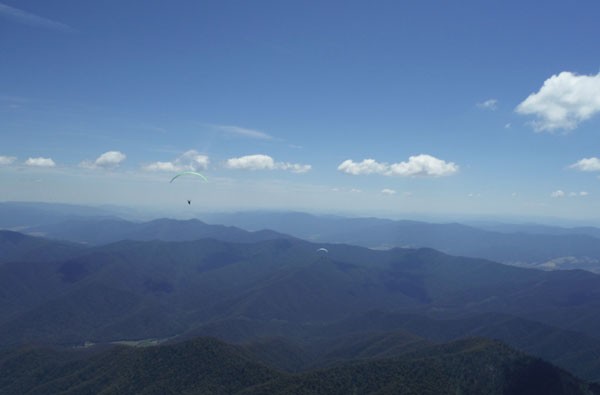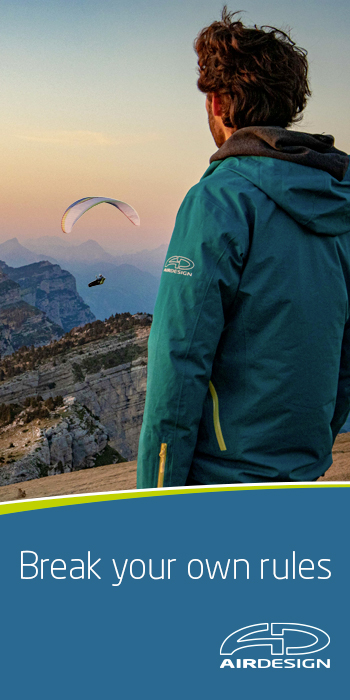
Fear vs. Risk Management – Kirsten Seeto writes from down-under
Kirsten Seeto, cross-country pilot, competitor and avid paraglider blogger shares her views on fear and Risk Management. In her blog she analyses her own trials and tribulations, and find that assessing one’s ability to others with similar risk profiles can bring a lot to the table.

Fear vs. Risk Management
I had just landed, kicking the dust in disappointment, on the ground way earlier than I had hoped. I forced myself to get on with it, send my location, pack my gear and get to the road. As I packed my gear, I considered the factors that lead to me being on the ground. I had been following friends, top pilots, across the Tawonga Gap — a stretch of un-landable alpine pass. It’s a popular route to take from Mystic, if you can get enough height, which deposits you in the Kiewa Valley where you can follow the valley around and attempt a triangle back to Bright. I’ve crossed the gap a handful of times — none resulting in a successful triangle return. I thought that this time I would get closer, being able to observe the pro’s. So where did I go wrong?
I didn’t actually manage to pin-point my error till I had a chance to debrief with the friends I was following. “Why did you take that route over the pass?”, they asked. I had believed I was taking the same route as them, but upon further questioning I realised I had taken the shortest route over the pass, putting myself as quickly as possible within safe glide to easy landing options. I always take that route when crossing the pass. My friends took a route that left them over the high ground for longer. High ground = greater chance of finding triggers. So I reasoned with myself that they were willing to take more risks than I was. I wanted safety first. Another friend asked me about this flight and challenged me on this. Were the other pilots really putting themselves at risk? How safe is too safe? If I wanted to stay as safe as possible I should probably not take off. Perhaps the answer is you want to fly safe enough. How do we define that??
Following on my original line of thought that better pilots took more risks, I started to question better pilots — “How undesirable is a tree landing for you, on a scale of 1–10, where 10 is worst outcome ever”. I was surprised to hear them all come back with “10”. So my friends who appeared to be taking additional risk by staying back from the ridge (i.e. in lift), were still confident of being able to glide out if they didn’t manage to maintain height. If I was going to fly my Kiewa Valley triangle successfully I needed to stretch my boundaries and expect to find lift where it’s likely to be (i.e. on the high ground). Leave flying out to safe landing when that’s the issue I need to deal with. I’m not talking about being unsafe — I’m talking about dealing with landings when my height and glide require me to do so. When I’m at 2300m with an easy glide to the valley, I shouldn’t be thinking about landing.
What’s interesting about this anecdote is that risk management is different for different pilots. It’s based on experience, knowledge of an area and knowledge of your glider. What one person perceives to be unsafe, another can perceive to be safe. How often do you hear people on launch say something to the effect of “I don’t feel safe, therefore you shouldn’t fly”? In my example, I feel it would be safe for me to stretch my boundaries more and calculate my risks more realistically. Other people may not want to stretch their boundaries so much.
The other factor that comes in to play when assessing the risk of a particular route is your risk profile. This is totally intrinsic to you. What is the impact of having an accident that puts you out of action for 3–6 months? Do you have a family that relies on you for income, for day-to-day organisation? Do you have income insurance? Would you be out of pocket if you were incapacitated for this long? Would that impact your ability to meet your financial obligations? Maybe it just comes down to how your significant-other would react to an accident? Would that be the end of flying for you, even if it was a minor accident? Would an accident just mean a period of inconvenience and boredom but an otherwise mere blip in your flying career? These questions have nothing to do with your ability as a pilot, but they do have a significant part to play in how you fly.
Jeff Ambrose wrote a really good article on paragliding and risk management recently. One point he made really struck a cord with me — and that was that you should hang out with pilots with a similar risk profile. If you have a family that is going to be mightily unimpressed with you having an accident, life is going to be a whole lot easier and enjoyable if you hang out with other pilots with similar responsibilities. If you hang out with the 30-somethings with no family and no partner, and jobs that allow them to take days off whenever the flying is good, chances are your paragliding life is going to get stressful. You are going to want to take days off you can’t really afford, and be encouraged to fly lines that a little voice inside of you is insisting you probably shouldn’t.
Similarly, if your lifestyle means that you can stretch the boundaries more and afford to make compromises in your life to accomodate more flying, you are probably not going to get as much out of your flying as you could if you hang out with people with family responsibilities. A friend of mine commented recently how his flying style used to attract a lot of criticism from local pilots. He loved pushing the envelope and stretching his own boundaries. He never felt that he was flying dangerously, but rather that he was managing his own risk. Pilots with very different risk profiles labelled him as fearless. He lamented, in fact, that he would have loved to have flown more often with pilots of a similar risk profile to him.
Often we label that inner voice telling us what we should and shouldn’t do as ‘fear’ and leave it at that. I think fear is a name we give something that we don’t understand and then feel really uncomfortable about. By getting better at calculating risk (rather than labelling something we cannot/have not calculated the risk for as ‘unsafe’) and being aware of our own risk profile (and choosing to fly with like-minded pilots) then the fear should start to subside and be replaced with rational decision-making and a greater understanding of ourselves and our boundaries.
Look around at the pilots you fly with; the ones you enjoy flying with the most. Consider their risk profiles. Then think of a time where you were really uncomfortable about flying but felt some sort of social pressure from other pilots to fly anyway. How did your experience and knowledge compare to the other pilots? How did your risk profiles compare?
When I consider my initial example, following more experienced pilots on a route who had a similar risk profile to me, I can understand 2 things. The first is that I believe I am being too cautious for my ability and experience. I want to stretch my boundaries more and extend my flying. It’s not about taking more risks — its about being realistic on when I need to move out to safe landing and when I can enjoy the benefits of higher altitude and higher ground. The second is that I am hanging out with pilots of similar risk profile to me, which is probably why I am having a great time with my flying right now. These pilots are a bit more experienced than me, challenging me often but not so much that I am constantly being pushed out of my comfort zone.
Paragliding is a never-ending journey 🙂
– Kirsten Seeto

DISCOVER

Stay in touch with the most popular publications by receiving for our NEWSLETTER Fast and easy – takes 1 minute!


